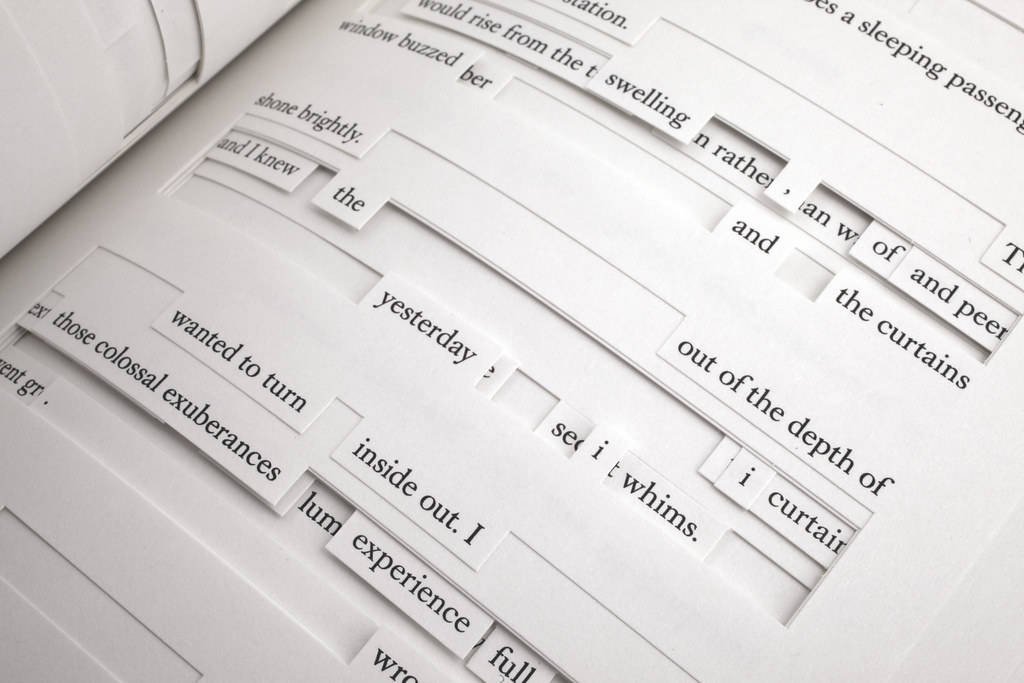According to the Visual Editions, the publisher's website, "As Jonathan began to carve out his story, we started doing our production homework and literally got turned down by every printer we approached – their stock line being “the book you want to make just cannot be made”. Thankfully, we found Die Keure in Belgium who relished the challenge of making a book with a different die-cut on every page." (http://www.visual-editions.com/our-books/tree-of-codes)
I find it so interesting that so many aesthetic options emerged from the basic concept of altering existing text: He could of printed the new text in normal paragraphs in either print or digital form. He could have published it with blacked out or struck out portions and this would have changed the tone and experience to that of a censored object. The cut-out option seems the most materially dynamic because we are presented with layers of exposed or partially exposed words. Some of them are legible right away and with others the reader must negotiate whether this is part of the immediate story or something that will only be meaningful later on. I have to mention here that Kirschenbaum and Werner used Tree of Codes as an almost paradoxical example of the digital humanities (p.446). While the component of physical interaction with the text is crucial, they point out that this book could not have been produced on a mass scale without digital intervention to produce the cuts. Therefore the book is actually a collaborative work, combining old and new technologies to create a unique experience.
 |
| Tree of Codes from Visual Editions: https://www.flickr.com/photos/visualeditions/5132830443 |
Last thoughts: I already brought up the fact that producing such a complex book was achieved with the help of computers and lasers and digital design. If this was supposed to be impossible to make as a codex, I wonder if there could be a wholly digital version? Would the effect be lost? Could you effectively mimic the covering and revealing effect? Would it be more or less confusing? Would it still be book art since it's already sort of digitally-born book art?
Citation and links:
Kirschenbaum, Matthew G. and Sarah Werner. "Digital Scholarship and Digital Studies: the State of the Discipline," Book History 17 (2014): 406-58.
Safran Foer, Jonathan. Tree of Codes. London: Visual Editions, 2010.
"Tree of Codes". Visual Editions. Accessed January 21 2015. http://www.visual-editions.com/our-books/tree-of-codes
Tree of Codes at UTL and TPL
Citation and links:
Kirschenbaum, Matthew G. and Sarah Werner. "Digital Scholarship and Digital Studies: the State of the Discipline," Book History 17 (2014): 406-58.
Safran Foer, Jonathan. Tree of Codes. London: Visual Editions, 2010.
"Tree of Codes". Visual Editions. Accessed January 21 2015. http://www.visual-editions.com/our-books/tree-of-codes
Tree of Codes at UTL and TPL
Thanks for sharing this Chrissy! For some reason when I look at the image of the book in your post I am immediately reminded of on-screen text. It may be because the formatting of the text appears disjointed making its layout aesthetically distinct from your typical printed page (and more so like the loose, and sometimes erratically styled text you see in on-screen books or writing when something's gone askew).
ReplyDeleteInterestingly enough when you compare this text to an online text I think there are definite similarities. First there's the fragility of the text. I think the physical preservation of this text likely requires more attention than your typical printed book,which echoes some of the issues that arise with the preservation of digital texts and maintaining their "stability". I also see a connection between Tree of Codes and digital texts in that they promote textual alteration. Here I'm thinking of the creative commons licensing that is becoming more common with some forms of online writing. Of course, taking someone's writing that's under CC licensing and re-working it isn't the same physically, but it does point the potential intricacy of online texts and the many "layers" of authorship or editing that they may undergo in their time online.
Thanks for this post Chrissy, you've made me want to sit down and read Tree of Codes! I was introduced to it in Professor Galey's bibliography class last semester, but only had a few minutes to read the first two pages as it was being passed around the class. I also struggled to decide which words to read- only the ones on the page or the ones you can also see the through the pages- and took some time trying to do both. I was struck by the beauty of the sentences constructed by cutting out words and phrases, and by the images they evoked, but this also left me wondering what the pages had said before they were cut up. It was an interesting experience to be thinking about both the source book and the book in my hands at the time, and in the end, I decide I should read both The Street of Crocodiles and Tree of Codes, and you have definitely reinforced this decision.
ReplyDelete